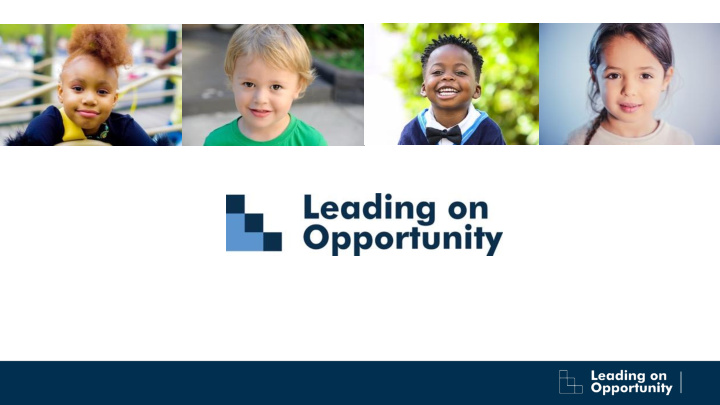



Charlotte Ranked Last • 2
The Fading American Dream Percent of Children Earning More than Their Parents, by Year of Birth. www.equalityofopportunity.org 3
Economic Mobility of Charlotte’s Children Born in Bottom 5 th Quintile Bottom Second Middle Fourth Top Quintile (5 th ) Quintile (4 th ) Quintile (3 rd ) Quintile (2 nd ) Quintile (1 st ) 38.2% 31.5% 17.3% 8.7% 4.4% Only 4.4% Chance to Make It To the Top. 70% of Children Born Poor Will Stay in the Bottom Two Quintiles. Source: Chetty, et. al, “Where is the Land of Opportunity? The Geography of Mobility in the United States.” • 4
“Potential is universal, opportunity is not,” Wes Moore, CEO, Robinhood Foundation • 5
Our Response
Our Bold, Inspiring Vision Charlotte Mecklenburg is a community that cares about all our children and youth – regardless of income, race, and zip code – and where all our children feel they belong, dream big, and find the opportunities to achieve their dreams.
A Layered Approach What about families most What are the attributes of individuals for success? creates or constrains ▪ Hopes/Aspirations opportunity? ▪ Family Structure ▪ Skills/Preparedness ▪ Family Traditions/Values ▪ Connectedness/Social Capital Individual ▪ Family Planning ▪ Resilience/Grit ▪ Family Income ▪ Parenting Skills/Resources What in our community network of resources, What are systemic or programs, support most underlying forces and creates or constrains structures that most opportunity? create or constrain opportunity? ▪ Neighborhood Characteristics ▪ Education Programs ▪ Housing ▪ Life-Skills Programs ▪ Education ▪ Criminal Justice Programs ▪ Criminal Justice ▪ Workforce Development Programs ▪ Segregation ▪ Faith Community ▪ Cultural Values/Norms ▪ Business Community ▪ Explicit/Implicit Bias ▪ Exclusion/Inclusion ▪ Hiring Practices ▪ Income Inequality/Wages
Must be addressed as a Requires long system. term approach with honest appraisals of effectiveness. Focus on relationships and linkages.
Prenatal to Career Continuum 3 rd Grade 8 th Grade 12 th Prenatal Birth Kindergarten College and Support and Grade/High Career Decisions School Pathways Graduation 2019 2020 2025 2028 2033 2038 Through 2050 10
Opportunity System Strategy For Children, Youth and Families
The Opportunity Commit to: • Relentlessly focus on systems change. • Advocate for policies to better serve youth and families. • Focus on creating new pathways to mobility and bridge the opportunity gap. • Recognize that no single organization is the answer. • Facilitate cross-sector collaboration to achieve the generational results we seek to achieve. • 12
Community-Inspired Strategies *Segregation: Cross-Cutting Factor* ▪ Strategy A : Acknowledge the significant roles segregation and ✓ Become a More racialization have played in our current opportunity narrative Inclusive, Fair and and commit to becoming a more inclusive, fair, and just Just Community. community. ✓ Address School ▪ Strategy B: Address the complex, multifaceted issue of school segregation with a systems approach. Segregation
Community-Inspired Strategies: Social Determinants
Community-Inspired Strategies *Social Capital: Cross-Cutting Factor* ▪ Strategy U : Ensure all children, youth, and families have ✓ Expand Relationships relationships in the community that connect them to opportunities, and Connections to information, and resources; broaden their horizons about what’s Broaden Horizons. possible in their lives; assist in navigating through unexpected crises to stay on track; offer tangible pathways toward achieving their aspirations; and demonstrate to every child, youth, and family that their contribution is vital to the success of our community.
Economic and Social Mobility: The Defining Issue of Our Time • 16
Community Response
T w f P P What is MECK Pre-K? ’
CELC Framework: Engage across the education continuum and crucial supporting services ▪ ▪ ▪ ▪ ▪ ▪ ▪ ▪ ▪ ▪ ▪ ▪ ▪ ▪ ▪ ▪ ▪ ▪ ▪ ▪ ▪ ▪ ▪ ▪ ▪ ▪
The Challenge Charlotte Mecklenburg is a place of But often we opportunity don’t live, We don’t see for many. learn, work each other. or worship We don’t face together. what keeps us separate. We don’t see disparities.
The Challenge • 25% of Charlotte’s children experience poverty. • 44% of Mecklenburg County children ages 0-5 live in households earning below 200% of the Federal poverty level. • The poverty rate of working age African Americans and Hispanics is twice that for whites in Charlotte. • 14.5% of young people ages 16-24 are neither working nor going to school or training. • 22
We Are Segregated By Race
We Are Segregated By Income
Ensure Opportunity for All.
Before Making Significant Decisions, Ask “How will this decision impact the opportunity trajectory of our children, youth and families?” Your actions can make a tangible impact. • 26
Be An Opportunity Ambassador Read the Opportunity Task Force Report Visit www.leadingonopportunity.org and share your story Talk with Others About This Work Ask Questions of Your Elected Leaders Follow Us On Social Media: Facebook & Twitter Volunteer, Donate Time and/or Talent • 27
Our Children. Their Future. Our Commitment.
Recommend
More recommend